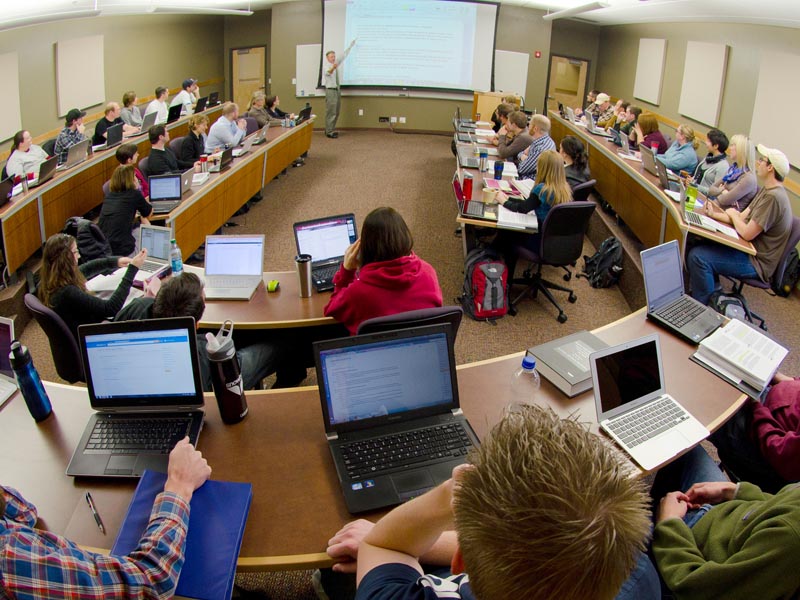- Editorial Offices
- 203 Brantly Hall
- Missoula, MT 59812
- (406) 243-2488
- themontanan@umontana.edu
Programs for Progress
New UM programs have far-reaching impacts.
On a frosty day in mid-December, about 200 people gathered within the warm walls of spectrUM Discovery Area in Missoula. UM’s hands-on science center is a colorful space often filled with children exploring the wonders of water, gravity and the solar system through a variety of exhibits. On this particular day, it brimmed with a who’s who of science and health community leaders. The crowd buzzed with anticipation to hear about Zero to Five, a $16.7 million strategic initiative, funded by Headwaters Foundation and anchored at UM, which would invest in one of the most critical stages of Montana’s youngest children.
Research shows the 0-to-5 age window is developmentally critical for children. When children lack basic needs, including food, health care, safety and intellectual stimulation, the negative effects reverberate for years to come, often leading to advanced problems as adults that require greater investment from society. Headwaters Foundation, the nonprofit funding the initiative, learned from western Montana communities about the need to fill those gaps, and they recognized in UM the expertise to lead the way.
Brenda Solorzano, CEO of Headwaters Foundation, told how the initiative came to be, describing half-jokingly about having “600 cups of coffee up and down Montana” with stakeholders and holding 16 community meetings in 16 counties, including the Flathead Reservation, to figure out where the work needed to
be done.
But it’s UM that Headwaters has trusted as the hub for this major undertaking. The University will administer $5.2 million of the grant for the program office and will serve as the go-to resource for the program’s major collaborators, which include the UM Center for Children, Families and Workforce Development; Healthy Mothers, Healthy Babies; and the Childwise Institute.
At UM’s College of Health Professions and Biomedical Sciences, which will serve as a partner for the initiative, the funding will support faculty and students to coordinate the endeavor. The college is renowned for cutting-edge research in areas like preventative care and holistic health education, and for forming interdisciplinary collaborations both on campus and in the community.
“As a research university, UM is poised to address the emerging and complex issues of our time,” says Reed Humphrey, dean of the college. “Zero to Five aligns with our growing expertise in health and medicine, and we’re delighted to be a partner.”
Private grants like Zero to Five support new programs at UM that enhance student experience and elevate colleges and schools on campus in ways that have far-reaching impacts.
Another example of the power of philanthropy is the $1 million grant recently extended by the Madrona Hill Foundation to elevate UM’s Health and Medicine Initiative. The program was launched in 2016 to support improved health for Montana residents through strategic partnerships and by educating practitioners to serve rural communities across Big Sky Country.
With the Madrona Hill Foundation’s seed funding, the initiative will help launch an occupational therapy training program at UM that was approved in May 2017 in collaboration with Montana State University-Billings, fund fellowships for doctoral students in public health and provide scholarships for students in health care fields who plan to practice in rural and underserved areas of Montana and
the region.
UM’s Flathead Lake Biological Station is another program supported through private gifts. The station is a worldwide leader in freshwater research, and right now it’s engaged in vital work to prevent invasive mussels from invading and potentially ruining an ecosystem that stretches from Montana to the Pacific.
And while FLBS is one of UM’s oldest funded programs, the Montana Media Lab exemplifies a new exciting program supported by private donors. The lab, directed by Anne Bailey, is housed in the School of Journalism to help UM students learn how to tell multimedia stories and engage audiences through modern technology and platforms.
The lab will help make UM and Missoula a center for new media projects. Workshops taught by professionals from around the world will provide expertise in subjects such as web design, data visualization and social media strategy. And like so many privately funded programs, it allows a unit like the School of Journalism, which has long been ranked among the best in the nation, to continue providing students with a transformative education.




